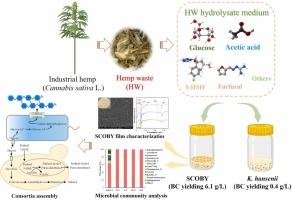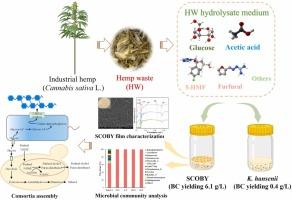A sustainable strategy for biosynthesis of bacterial cellulose using a microbial symbiotic culture from hemp (Cannabis sativa L.) waste hydrolysate
IF 6.2
1区 农林科学
Q1 AGRICULTURAL ENGINEERING
引用次数: 0
Abstract
Bacterial cellulose (BC) is a bio-macromolecular material with outstanding properties, making it highly promising for diverse applications. The bioconversion of lignocellulosic biomass into BC is crucial for advancing sustainable economic and societal development. Here, industrial hemp waste (HW) was used for BC production, facilitated by a symbiotic community of bacteria and yeast (SCOBY) derived from Kombucha. At the same time, liquid hot water (LHW) pretreatment was employed to optimize the valorization of industrial HW, achieving a maximum glucose yield of 39.7 g/L and cellulose conversion of 71.2 % following enzymatic hydrolysis. The resulting hydrolysate was directly used for BC production without detoxification. Compared with the conventional BC producer Komagataeibacter hansenii, SCOBY showed superior tolerance to inhibitors, yielding 6.1 g/L of dried BC. Furthermore, the characterization results revealed that the SCOBY-derived BC exhibited excellent surface porosity, swelling and water holding capacity, indicating its potential for biomedical applications. Taxonomic analysis identified the yeast genus Brettanomyces and the bacterial genus Komagataeibacter as the most abundant taxa in the SCOBY grown in HW hydrolysate. Notably, introducing B. bruxellensis from SCOBY into co-culture with K. hansenii effectively mitigated the inhibitory effects of HW hydrolysate and improved BC production. This study proposes a sustainable strategy for BC production and provides insights into the mechanisms by which the SCOBY consortium tolerates inhibitors during the utilization of lignocellulosic biomass hydrolysate.


利用大麻(大麻sativa L.)废物水解物的微生物共生培养物生物合成细菌纤维素的可持续策略
细菌纤维素(BC)是一种性能优异的生物大分子材料,具有广阔的应用前景。木质纤维素生物质转化为BC对于促进经济和社会的可持续发展至关重要。在这里,工业大麻废料(HW)被用于生产BC,促进了细菌和酵母(SCOBY)的共生群落从康普茶。同时,采用液体热水(LHW)预处理优化工业HW的活化,酶解后葡萄糖产率最高为39.7 g/L,纤维素转化率最高为71.2 %。所得水解液直接用于生产BC,无需解毒。与传统的BC产生菌Komagataeibacter hansenii相比,SCOBY对抑制剂的耐受性更强,干燥BC的产量为6.1 g/L。此外,表征结果表明,scoby衍生的BC具有优异的表面孔隙度、膨胀性和持水性,表明其在生物医学上的应用潜力。分类分析表明,酵母属Brettanomyces和细菌属Komagataeibacter是HW水解液中生长的SCOBY中最丰富的分类群。值得注意的是,将SCOBY中的bruxellb与hansenii共培养有效地减轻了HW水解产物的抑制作用,提高了BC的产量。本研究提出了一种可持续的BC生产策略,并提供了SCOBY联盟在利用木质纤维素生物质水解物过程中耐受抑制剂的机制。
本文章由计算机程序翻译,如有差异,请以英文原文为准。
求助全文
约1分钟内获得全文
求助全文
来源期刊

Industrial Crops and Products
农林科学-农业工程
CiteScore
9.50
自引率
8.50%
发文量
1518
审稿时长
43 days
期刊介绍:
Industrial Crops and Products is an International Journal publishing academic and industrial research on industrial (defined as non-food/non-feed) crops and products. Papers concern both crop-oriented and bio-based materials from crops-oriented research, and should be of interest to an international audience, hypothesis driven, and where comparisons are made statistics performed.
 求助内容:
求助内容: 应助结果提醒方式:
应助结果提醒方式:


